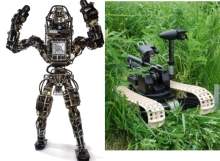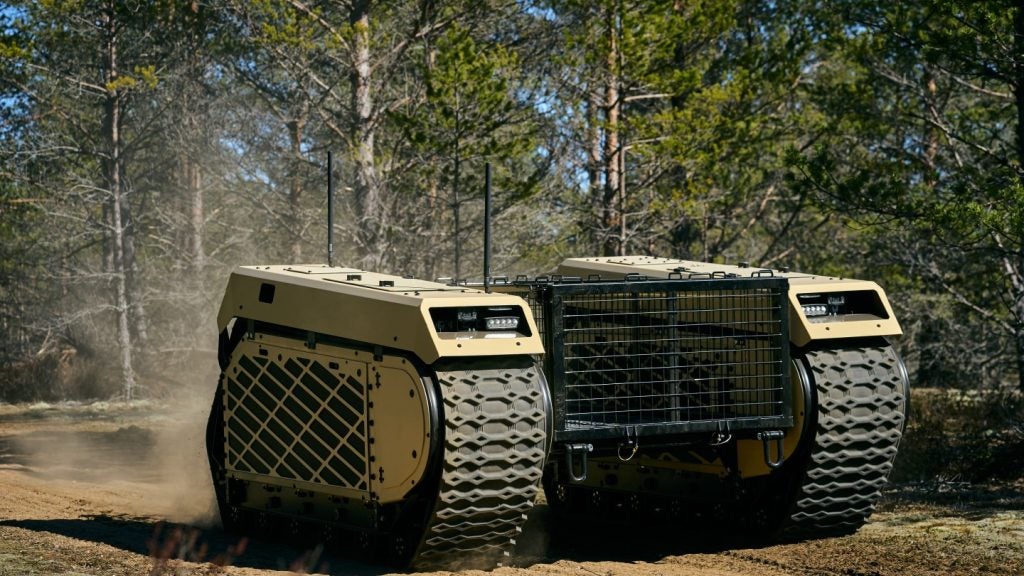

Since the earliest science fiction books, battlefield robots have been portrayed as standing fierce and fearless on two legs with glowing eyes targeting futuristic enemies. Military robots deployed to date have fallen far short of the fantasist’s humanoid design; typically they are tracked or wheeled, wielding factory-inspired manipulators and sensors.
That’s not for want of trying on the part of the defence innovation giants. While not alone, Google‘s recent acquisition Boston Dynamics is one of the companies best known for its realistic looking and convincingly moving humanoid robots for the US military, notably Atlas and PetMan. Impressive footage of these advanced designs in action in the laboratory makes them seem nearly battlefield ready, so why haven’t they been deployed yet?
Operating in an environment designed for humans
Prof. Noel Sharkey, Professor of Artificial Intelligence and Robotics at Sheffield University, says: “At present, I don’t think a humanoid design would be a good strategy in terms of military applications; the tank-like ones and flying ones seem much more useful.”
But Prof. Samia Nefti-Meziani, Chair in Intelligent Systems and Robotics at the University of Salford, argues that one of the drivers for the development of humanoid robots is they would be able to operate easily in environments designed for human. This would make them better suited for city-based door-to-door combat and manipulating everyday objects like doorknobs.
Sharkey agrees, adding: “You could drop a humanoid robot onto a ship, have it break in, walk down stairs and, take over a console desk, and arm or disarm a weapons system. A flying robot couldn’t do that.”
How well do you really know your competitors?
Access the most comprehensive Company Profiles on the market, powered by GlobalData. Save hours of research. Gain competitive edge.

Thank you!
Your download email will arrive shortly
Not ready to buy yet? Download a free sample
We are confident about the unique quality of our Company Profiles. However, we want you to make the most beneficial decision for your business, so we offer a free sample that you can download by submitting the below form
By GlobalDataChallenges to overcome
While state-of-the-art bipedal military robots have been demonstrated walking, running and traversing difficult terrain, they may not have entirely overcome the challenge of balancing on two legs. Boston Dynamics’ Atlas was shown to withstand being hit by a swinging weight with barely a stagger, for example, but out of the laboratory it broke an ankle tackling a none-too-challenging obstacle during a recent demonstration. And few of its ilk would stand up to one good, hard shove.
And while the stability problems still loom large, further challenges lie ahead in the fact that human locomotion is about far more than just walking.
“Walking’s one thing, but humans can crouch, lie down, crawl, stand up quickly,” says Sharkey. “Robots can’t really jump yet, then there’s all the manipulation and working the arms; it’s very difficult to get that done in a human-like way.”
Not to mention the fact that breaking out of the traditional robot mould comes at a cost.
“Humanoid robots are currently highly expensive but this is because they are still pieces of research,” says Nefti-Meziani. “The number of components in a typical humanoid robot is less than in a modern car but researchers talk about humanoid robots selling for similar amounts of money. Specific military requirements would raise this still further.”
Once bipedal locomotion is sorted, robots will on-board technology to carry out their mission once they reach their destination.
“Any targeting or vision system moving the head around, looking, scanning; all that kind of technology will all come into general use,” says Sharkey. “Researchers are also working on the ability to classify objects – what is a tap, what is a spanner, for instance. But that is still incredibly difficult; the AI side needs to catch up with the mobility.”
What different robot designs could do better
Given the drawbacks of humanoid design, might different shapes be more suitable for military robots?
“One of the drivers for the development of humanoid robots is they would be able to operate easily in environments designed for humans,” says Nefti-Meziani. “However, there are other body formats equally suited to our environments which have other benefits such as improved stability or load carrying capacity. Four legs provide a much more stable base and are generally better suited to locomotion on uneven terrain than bipeds – the DARPA-funded BigDog robot, for example.”
Sharkey believes we may even be restricting robots by making them human like, when they could be superhuman. “They could have a far wider range of movement, or the arms themselves could be jointed machine guns,” he says.
Body part spin-offs
That’s not to say all the research being carried out on humanoid robots will go to waste as the individual functional parts could be used for specific roles.
“The development of dexterous robot hands has seen a great deal of research for humanoid robots, as well as telepresence and telerobotics, whereby a robot is able to enter a dangerous environment and act as a remote representation of the human operator,” says Nefti-Meziani.
“This technology is being explored for various applications such as disaster relief or in space. NASA has developed the Robonaught which has dexterous hands, the idea being that a remote operator drives and receives feedback from the robot and its hand allows the person to do work remotely.”
Similar technology would readily transfer to the military environment where this haptic feedback would give extra control to enable bomb disposal experts when handling explosive devices from a safe distance.
Exoskeleton alternatives
But where human-shaped mechanical assistance is required, there is an existing solution much closer to deployment that combines human dexterity, vision and decision-making with superhuman strength and endurance. Soldier-worn exoskeletons such as Lockheed Martin’s Human Universal Load Carrier (HULC), the US Special Ops’ Tactical Assault Light Operator Suit (TALOS) and the French Army’s Hercule are all very nearly battlefield-ready.
“In terms of soldiers, the exoskeletons are a big way forward, ” says Sharkey. ” It still makes you stand out like a target, though, and you can’t lie down too easily with it. You can walk quickly and it makes you very strong, but its mobility is the big problem.”
Not to mention that exoskeletons still bring soldiers into the line of fire whereas one of the key advantages of military robots is that they are designed to be operated from a distance, or with varying degrees of autonomy.
Fear factor
While it seems clear that a humanoid design may not be the best for battlefield robots, one factor that could be behind the military’s continued pursuit may be the sheer intimidation factor of seeing a two-legged robot armed to the teeth looming over the horizon.
“The iconic value and the scariness are important for the military and DARPA,” argues Sharkey. “It would be more like a robot commando, and though I’m not expecting to see Terminators on the battlefield, it has that kind of resonance to it when you’re dealing with trying to frighten your enemy.”
A question of time
Talking of Terminators, the films would have us believe a killer robot with a resemblance to a certain former governor of California will be mass-produced by Skynet in 2016, but it seems the actual deadline is a moving target.
“The question of when practical humanoid robots might become available has been asked many times and the answer for the last 30 years seems to have been ‘within the next ten years’,” says Nefti-Meziani.
“There are numerous humanoid robots which have been developed across the world and some are now being sold to research institutes and universities, while other simpler humanoid robots are commercially available. However, with recent interest in robotics from the likes of Google it may be that this time ‘within the next ten years’ really is the reality.”
In the end, it could be corporate money, as evinced by Google’s takeover of DARPA favourite Boston Dynamics, that helps propel military robots from the laboratory to the battlefield.
“Google has such a large amount of money, and although they’re not particularly military, any development will always help the armed forces,” says Sharkey. “It’s still very early days, so we have to keep an eye on them, but I might not be here to keep an eye on them when they are actually at the point of being able to be deployed.”
Follow Berenice Baker on Google+
Related content
Bio-inspired locomotion opens new paths for military robot design
Most military robots draw on mechanical models as a means of locomotion – tracks, wheels, fixed wings, helicopter rotors and propeller screws – but whole new groups of robotic agents are now evolving, inspired by the world of nature. Dr Gareth Evans reports.
Teleautonomy – improving remote robotic mobility and manipulation
Freed from their tethers and from minute-to-minute human guidance too, today’s robots are a far cry from their forebears. Dr Gareth Evans reports on how companies like Robotics Engineering Excellence (RE2) are working to equip military robots with greater levels of on-board decision-making capabilities – and perhaps, ultimately, full autonomy.


.gif)


